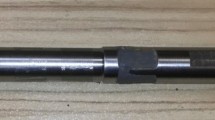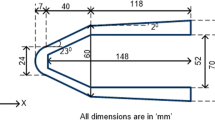Abstract
A force balance measures the forces being applied to an object in a wind tunnel test. The force balance needs to be optimized to generate an acceptable gauge reading while guaranteeing no structural failure by the wind tunnel loadings. This paper proposes a stepwise response surface method (RSM) for design optimization of a force balance. Three sampling techniques were tried in the RSM study, and finite element simulation was used for functional evaluation. The first trial was based on broad sampling, followed by a second trial based on narrow sampling. The data from these trials was then utilized in a final regression, in which a quadratic model was generated to identify the final optimum point. The final design of the force balance provides satisfactory gauge readings with decreased stress values even though the roll moment is greatly increased.
Similar content being viewed by others
Abbreviations
- K :
-
Gauge factor
- V r :
-
Bridge reading output
- ε i :
-
Strain gauge readings at ith strain gauge location
- x i :
-
ith design variable
- N :
-
Total number of design variables
- β :
-
Coefficient in the response surface model
- W :
-
Diagonal matrix for the weight values
- y best :
-
The most desired observation
- σ 0 :
-
Stress measured at the center point of sampling
- ε 0 :
-
Gauge reading measured at the center point of sampling
- y i :
-
ith value of the performance by variable set xi = {x1, x2, x3}i
- f(x i):
-
Quadratic polynomial function used to predict yi
- w σ :
-
Weight values for stress measure
- w ε :
-
Weight values for strain reading measure
- M :
-
Number of points used in the regression study
References
C. S. Kim, K. S. Hong and M. K. Kim, Nonlinear robust control of a hydraulic elevator, Control Engineering Practice, 13(6) (2005) 789–803.
R. S. Chandel and S. R. Bala, Effect of welding parameters and groove angle on the soundness of root beads deposited by the SAW process, Proc. of Trends in Welding Research, Gatlinburg (1986) 479–385.
R. P. Davie, Temperature Compensated Force Balance, Patent No. US2844027A, US Patent and Trademarks Office (1958).
D. Burns and P. Parker, Additively manufactured wind-tunnel balance, Journal of Aircraft, 57(5) (2020) 958–963.
M. Feero, A. Naguib and M. Koochesfahani, Single-component force balance for the measurement of low-magnitude mean aerodynamic loads, Measurement Science and Technology, 30 (2019) 11.
S. Post and M. Morris, Force balance design for educational wind tunnels, 2020 ASEE Annual Conference, Louisville (2010).
I. B. Tintoré, Design of a three-axis wind tunnel force balance, Bachelor Thesis, University of Zagreb, Croatia (2018).
Đ. Vuković and D. Damljanović, Evaluation of a force balance with semiconductor strain gages in wind tunnel tests of the HB-2 standard model, Proceedings of the Institution of Mechanical Engineers, Part G, J. of Aerospace Engineering, 229(12) (2015) 2272–2281.
P. Vadassery, Design, calibration and testing of a force balance for a hypersonic shock tunnel, Ph.D. Thesis, University of Texas at Arlington, USA (2012).
G. Kalaiarassan, M. Somanadh, C. Thirumalai and M. S. Kumar, One-dimension force balance system for hypersonic vehicle an experimental and fuzzy prediction approach, Materials Today: Proceedings, 5(5) (2018) 2.
M. W. Kniskern, Analysis of a six-component, flow-through, strain-gage, force balance used for hypersonic wind tunnel models with scramjet exhaust flow simulation, M.S. Thesis, North Carolina State University, USA (1990).
C. Abe, Aerodynamic force and moment balance, design, fabrication, and testing for use in low Reynolds flow applications, M.S. Thesis, Rochester Institute of Technology, USA (2003).
A. Aboelezz, Y. Elqudsi, M. Hassanalian and A. Desoki, Wind tunnel calibration, corrections and experimental validation for fixed-wing micro air vehicles measurements, Aviation, 23(4) (2019) 104–113.
J. Laurenceau and M. Meaux, Comparison of gradient and response surface based optimization frameworks using adjoint method, Proceedings of 49th AIAA/ASME/ASCE/AHS/ASC Structures, Structural Dynamics (2008) 1889.
W. Hare, J. Nutini, and S. Tesfamariam, A survey of nongradient optimization methods in structural engineering, Advances in Engineering Software, 59 (2013) 19–28.
A. Y. Aydar, Utilization of response surface methodology in optimization of extraction of plant materials, Statistical Approaches with Emphasis on Design of Experiments Applied to Chemical Processes, Intec (2018) 157–169.
Y. W. Liu and F. Moses, A sequential response surface method and its application in the reliability analysis of aircraft structural systems, Structural Safety, 16(1–2) (1994) 39–46.
Z. Ren, W. Li, R. Billinton and W. Yan, Probabilistic power flow analysis based on the stochastic response surface method, IEEE Transactions on Power Systems, 31(3) (2016) 2307–2315.
W. Zhao, F. Fan and W. Wang, Non-linear partial least squares response surface method for structural reliability analysis, Reliability Engineering and System Safety, 161 (2017) 69–77.
W. J. Hill and W. G. Hunter, A review of response surface methodology: a literature survey, Technometrics, 8(4) (1966) 571–590.
S. K. Bekera, H. Meena, S. Chakroborty and B. C. Meikap, Application of response surface methodology (RSM) for optimization of leaching parameters for ash reduction from low-grade coal, International J. of Mining Science and Technology, 28(4) (2018) 621–629.
K. Anwar, M. Said, M. Afizal and M. Amin, Overview on the response surface methodology (RSM) in extraction processes, Journal of Applied Science and Process Engineering (JASPE), 2(1) (2015) 8–17.
G. G. Wang, Z. Dong and P. Aitchison, Adaptive response surface method-a global optimization scheme for approximation-based design problems, Engineering Optimization, 33 (2001) 707–733.
B. Keshtegar, P. Hao, Y. Wang and Q. Hu, An adaptive response surface method and Gaussian global-best harmony search algorithm for optimization of aircraft stiffened panels, Applied Soft Computing, 66 (2018) 196–207.
Force Balance Design, NASA Internal Report, National Aeronautics and Space Administration (2009) (unpublished).
Creo CAD Software, https://www.ptc.com/ko/products/creo, PTC, Inc. (2021).
D. E. Burns, P. A. Parker, B. D. Phillips, T. L. Webb III and D. Landman, Wind Tunnel Balance Design: A NASA Langley Perspective, NASA/TM 2020-220570, National Aeronautics and Space Administration (2020).
Strain Gage Selection: Criteria, Procedures, Recommendations, http://www.vishaypg.com/docs/11055/tn505.pdf, Tech Note TN-505-6, Micro-Measurements, Vishay Precision Group, Inc. (2018).
Response surface designs, NIST/SEMATECH e-Handbook of Statistical Methods, https://www.itl.nist.gov/div898/handbook/pri/section3/pri336.htm (2021).
A. T. Eshghi and S. Lee, Adaptive improved response surface method for reliability-based design optimization, Engineering Optimization, 51(12) (2019) 1–19.
Acknowledgments
This research was supported by the NASA Langley Research Center (Contract 17947, 18994) and the University of Maryland at Baltimore County, Department of Mechanical Engineering (Graduate Assistantship 3000633775).
Author information
Authors and Affiliations
Corresponding author
Additional information
Thomas Chaisson received the M.S. in Mechanical Engineering, University of Maryland at Baltimore County, Baltimore MD, USA in 2021. He is currently a Manufacturing Engineer at Lockheed Martin, MD, USA. His main research interests include design optimization, design of experiment, computer aided design, and manufacturing.
Soobum Lee received the Ph.D. in Mechanical Engineering, Korea Advanced Institute of Science and Technology (KAIST), Daejeon, Korea, in 2007. He is currently an Associate Professor with the University of Maryland at Baltimore County, Baltimore, MD, USA. His main research interests include energy harvesting device design, structural topology optimization, and robust and reliability-based design optimization.
Devin E. Burns received the Ph.D. in Mechanical Engineering from Johns Hopkins University, Baltimore, Maryland in 2012. He is currently a Force Measurement Engineer at NASA’s Langley Research Center in Hampton, VA, USA. His interests include mechanics, mechanics of materials, sensors, and manufacturing.
Rights and permissions
About this article
Cite this article
Chaisson, T., Lee, S. & Burns, D.E. Design optimization of a wind tunnel force balance using stepwise response surface method. J Mech Sci Technol 36, 3071–3079 (2022). https://doi.org/10.1007/s12206-022-0537-4
Received:
Revised:
Accepted:
Published:
Issue Date:
DOI: https://doi.org/10.1007/s12206-022-0537-4




